International Finance Report: Portfolio Diversification and Governance
VerifiedAdded on 2022/11/18
|10
|2441
|496
Report
AI Summary
This report delves into the realm of international finance, examining the benefits of portfolio diversification in mitigating systematic risk and enhancing returns. It explores how global portfolios, structured in proportion to market distribution, can reduce risk, especially when national trade cycles are uncorrelated. The report also addresses the importance of corporate governance, defining its role in overseeing corporations and ensuring ethical practices. It highlights the shareholder and stakeholder methods, emphasizing the significance of considering various stakeholder interests. Furthermore, it discusses the impact of corporate governance on mutual funds, particularly concerning board composition, director compensation, and potential conflicts of interest, such as investment banks prioritizing their underwriting and advisory services over fund performance. The analysis includes empirical evidence from various studies, providing insights into fund performance, the influence of investment banking relationships, and the benefits of international diversification. The report concludes by underscoring the advantages of global portfolios in terms of risk-adjusted returns and the need for robust governance to protect investor interests.
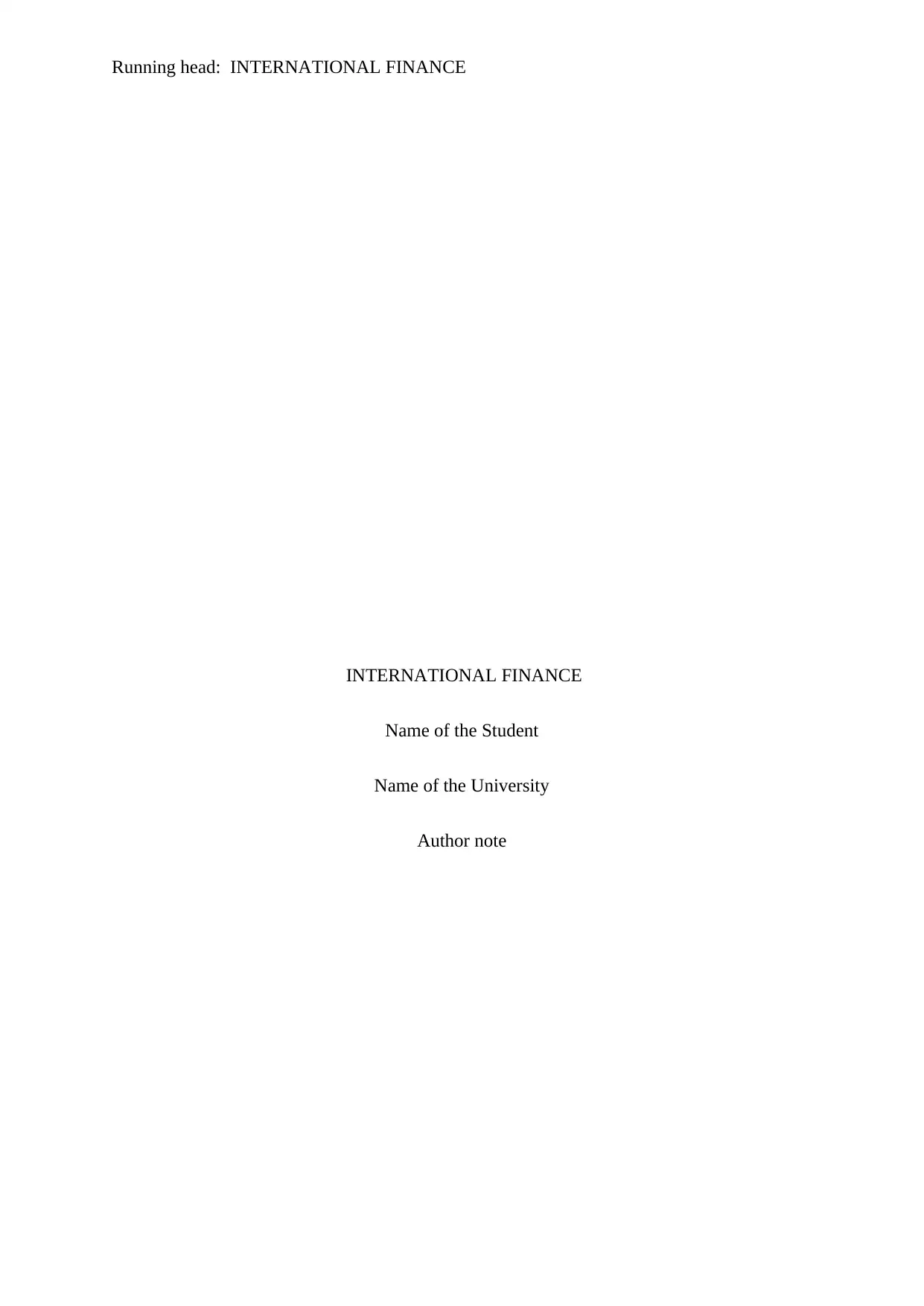
Running head: INTERNATIONAL FINANCE
INTERNATIONAL FINANCE
Name of the Student
Name of the University
Author note
INTERNATIONAL FINANCE
Name of the Student
Name of the University
Author note
Paraphrase This Document
Need a fresh take? Get an instant paraphrase of this document with our AI Paraphraser
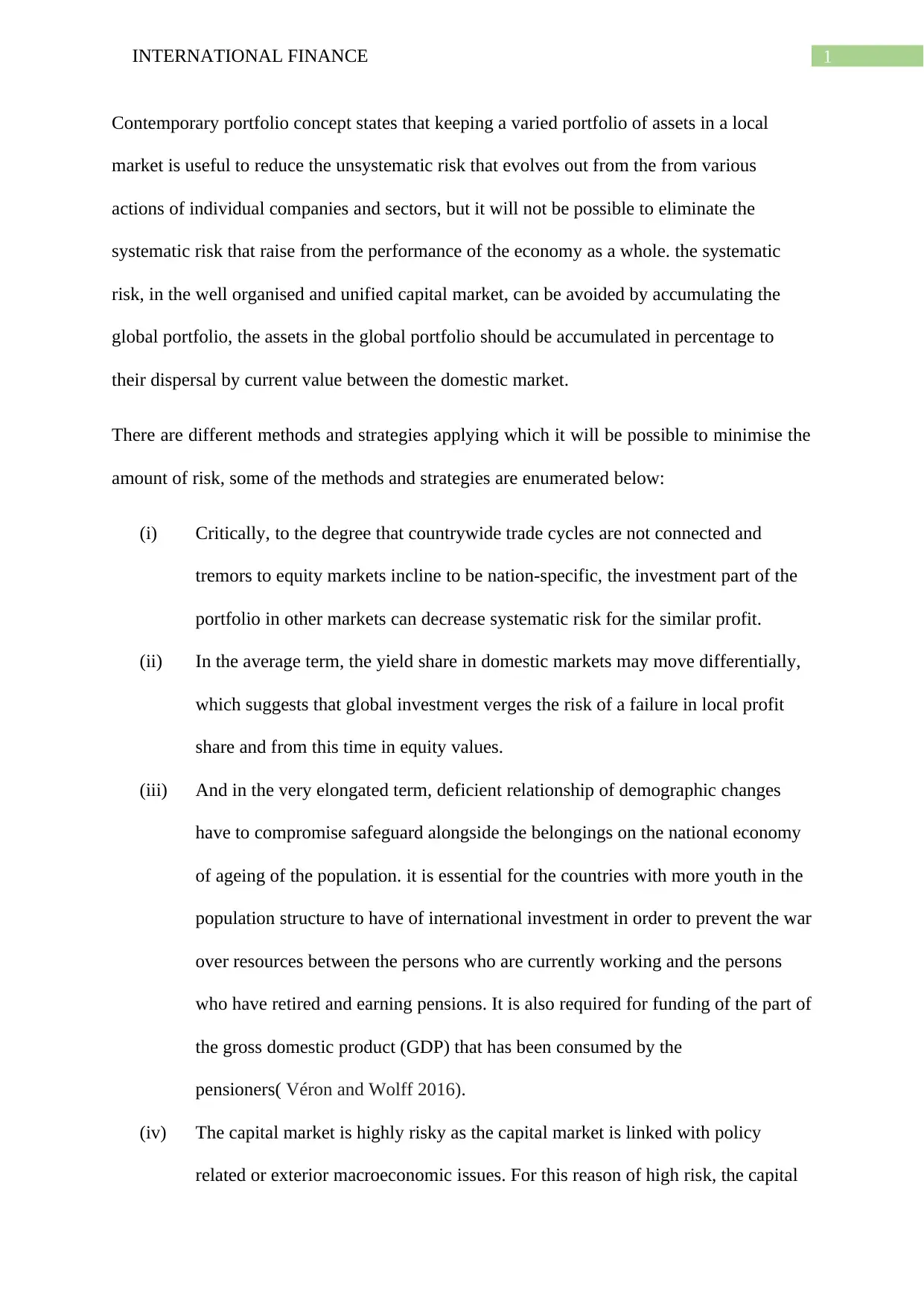
1INTERNATIONAL FINANCE
Contemporary portfolio concept states that keeping a varied portfolio of assets in a local
market is useful to reduce the unsystematic risk that evolves out from the from various
actions of individual companies and sectors, but it will not be possible to eliminate the
systematic risk that raise from the performance of the economy as a whole. the systematic
risk, in the well organised and unified capital market, can be avoided by accumulating the
global portfolio, the assets in the global portfolio should be accumulated in percentage to
their dispersal by current value between the domestic market.
There are different methods and strategies applying which it will be possible to minimise the
amount of risk, some of the methods and strategies are enumerated below:
(i) Critically, to the degree that countrywide trade cycles are not connected and
tremors to equity markets incline to be nation-specific, the investment part of the
portfolio in other markets can decrease systematic risk for the similar profit.
(ii) In the average term, the yield share in domestic markets may move differentially,
which suggests that global investment verges the risk of a failure in local profit
share and from this time in equity values.
(iii) And in the very elongated term, deficient relationship of demographic changes
have to compromise safeguard alongside the belongings on the national economy
of ageing of the population. it is essential for the countries with more youth in the
population structure to have of international investment in order to prevent the war
over resources between the persons who are currently working and the persons
who have retired and earning pensions. It is also required for funding of the part of
the gross domestic product (GDP) that has been consumed by the
pensioners( Véron and Wolff 2016).
(iv) The capital market is highly risky as the capital market is linked with policy
related or exterior macroeconomic issues. For this reason of high risk, the capital
Contemporary portfolio concept states that keeping a varied portfolio of assets in a local
market is useful to reduce the unsystematic risk that evolves out from the from various
actions of individual companies and sectors, but it will not be possible to eliminate the
systematic risk that raise from the performance of the economy as a whole. the systematic
risk, in the well organised and unified capital market, can be avoided by accumulating the
global portfolio, the assets in the global portfolio should be accumulated in percentage to
their dispersal by current value between the domestic market.
There are different methods and strategies applying which it will be possible to minimise the
amount of risk, some of the methods and strategies are enumerated below:
(i) Critically, to the degree that countrywide trade cycles are not connected and
tremors to equity markets incline to be nation-specific, the investment part of the
portfolio in other markets can decrease systematic risk for the similar profit.
(ii) In the average term, the yield share in domestic markets may move differentially,
which suggests that global investment verges the risk of a failure in local profit
share and from this time in equity values.
(iii) And in the very elongated term, deficient relationship of demographic changes
have to compromise safeguard alongside the belongings on the national economy
of ageing of the population. it is essential for the countries with more youth in the
population structure to have of international investment in order to prevent the war
over resources between the persons who are currently working and the persons
who have retired and earning pensions. It is also required for funding of the part of
the gross domestic product (GDP) that has been consumed by the
pensioners( Véron and Wolff 2016).
(iv) The capital market is highly risky as the capital market is linked with policy
related or exterior macroeconomic issues. For this reason of high risk, the capital
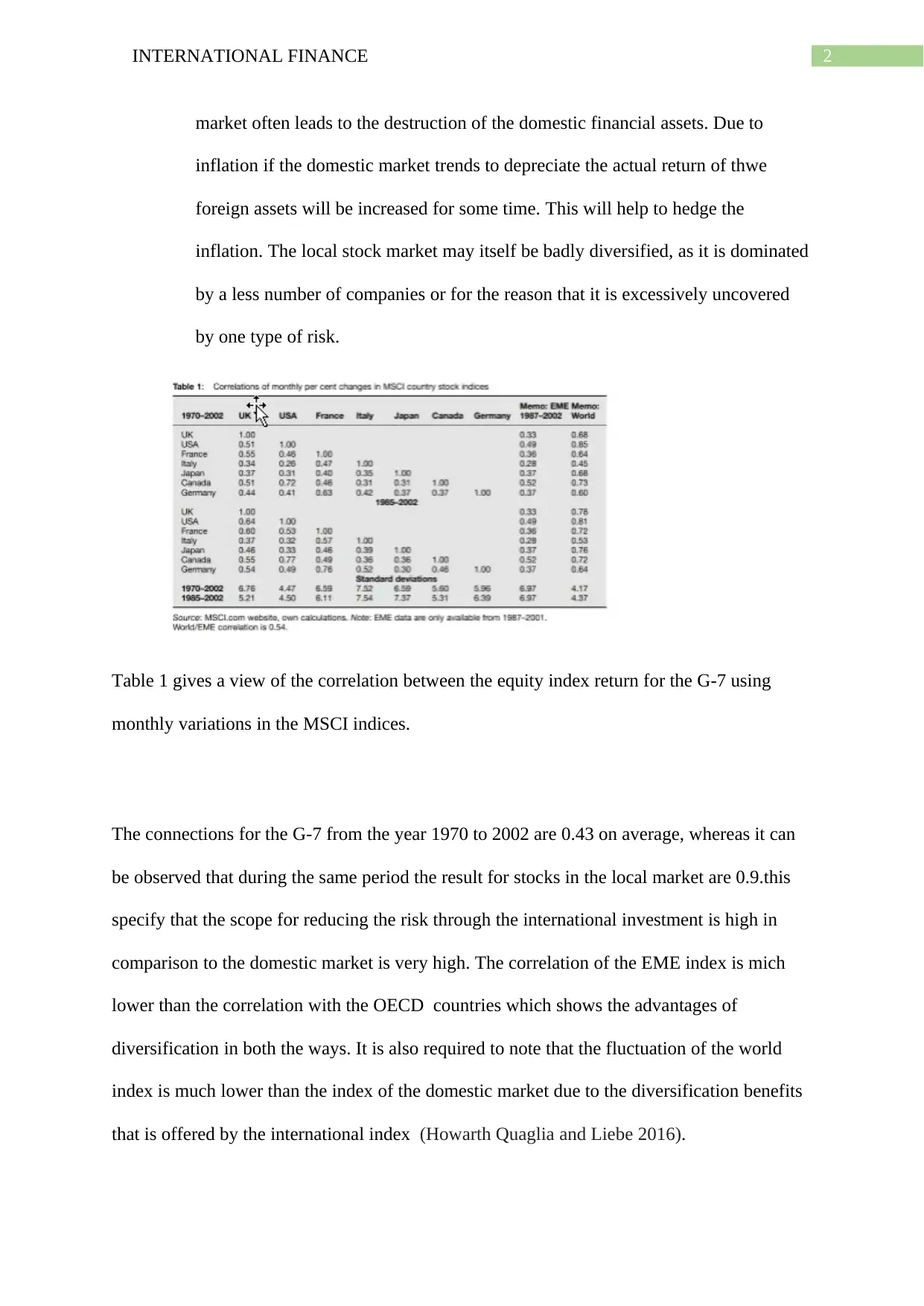
2INTERNATIONAL FINANCE
market often leads to the destruction of the domestic financial assets. Due to
inflation if the domestic market trends to depreciate the actual return of thwe
foreign assets will be increased for some time. This will help to hedge the
inflation. The local stock market may itself be badly diversified, as it is dominated
by a less number of companies or for the reason that it is excessively uncovered
by one type of risk.
Table 1 gives a view of the correlation between the equity index return for the G-7 using
monthly variations in the MSCI indices.
The connections for the G-7 from the year 1970 to 2002 are 0.43 on average, whereas it can
be observed that during the same period the result for stocks in the local market are 0.9.this
specify that the scope for reducing the risk through the international investment is high in
comparison to the domestic market is very high. The correlation of the EME index is mich
lower than the correlation with the OECD countries which shows the advantages of
diversification in both the ways. It is also required to note that the fluctuation of the world
index is much lower than the index of the domestic market due to the diversification benefits
that is offered by the international index (Howarth Quaglia and Liebe 2016).
market often leads to the destruction of the domestic financial assets. Due to
inflation if the domestic market trends to depreciate the actual return of thwe
foreign assets will be increased for some time. This will help to hedge the
inflation. The local stock market may itself be badly diversified, as it is dominated
by a less number of companies or for the reason that it is excessively uncovered
by one type of risk.
Table 1 gives a view of the correlation between the equity index return for the G-7 using
monthly variations in the MSCI indices.
The connections for the G-7 from the year 1970 to 2002 are 0.43 on average, whereas it can
be observed that during the same period the result for stocks in the local market are 0.9.this
specify that the scope for reducing the risk through the international investment is high in
comparison to the domestic market is very high. The correlation of the EME index is mich
lower than the correlation with the OECD countries which shows the advantages of
diversification in both the ways. It is also required to note that the fluctuation of the world
index is much lower than the index of the domestic market due to the diversification benefits
that is offered by the international index (Howarth Quaglia and Liebe 2016).
⊘ This is a preview!⊘
Do you want full access?
Subscribe today to unlock all pages.

Trusted by 1+ million students worldwide
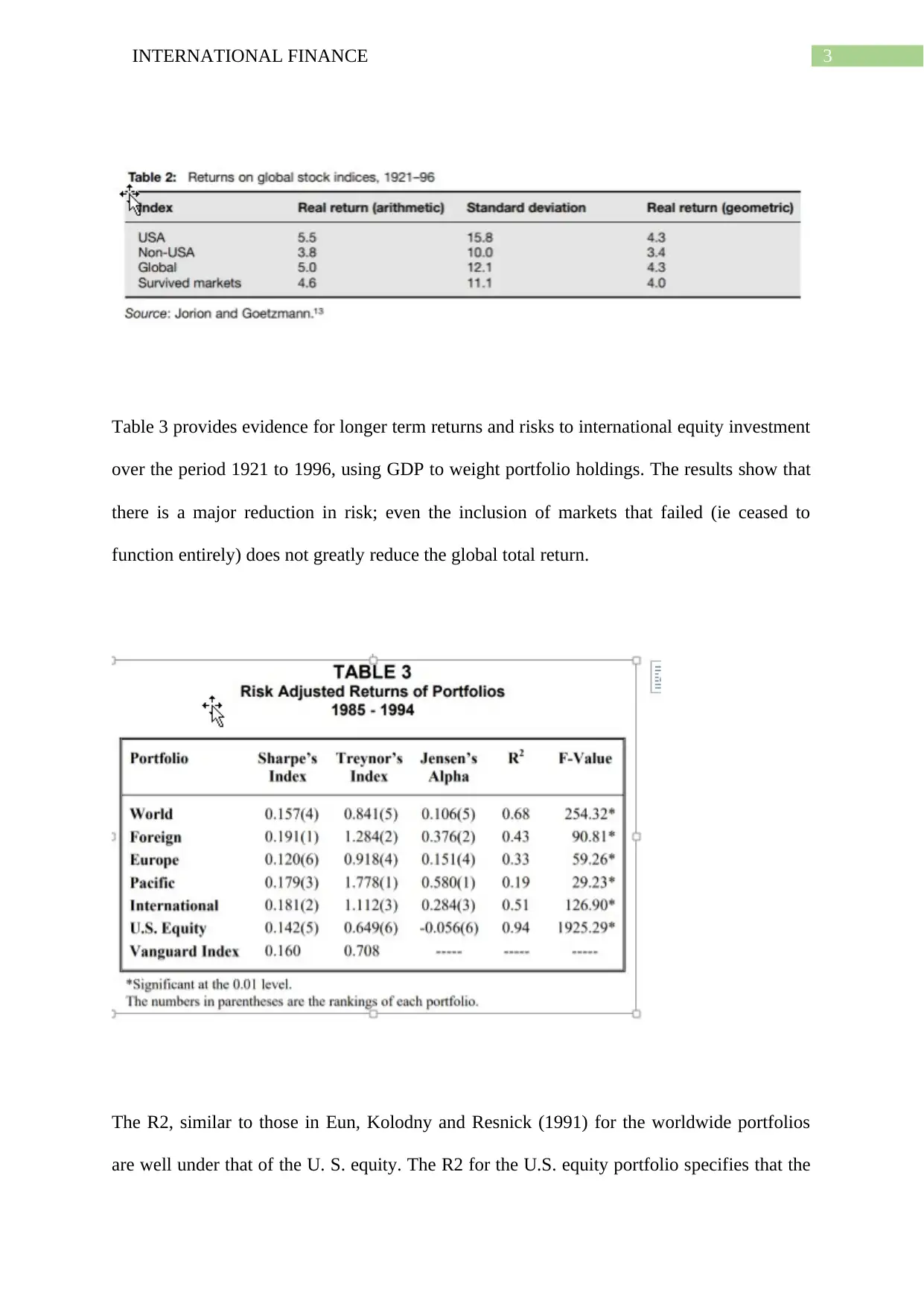
3INTERNATIONAL FINANCE
Table 3 provides evidence for longer term returns and risks to international equity investment
over the period 1921 to 1996, using GDP to weight portfolio holdings. The results show that
there is a major reduction in risk; even the inclusion of markets that failed (ie ceased to
function entirely) does not greatly reduce the global total return.
The R2, similar to those in Eun, Kolodny and Resnick (1991) for the worldwide portfolios
are well under that of the U. S. equity. The R2 for the U.S. equity portfolio specifies that the
Table 3 provides evidence for longer term returns and risks to international equity investment
over the period 1921 to 1996, using GDP to weight portfolio holdings. The results show that
there is a major reduction in risk; even the inclusion of markets that failed (ie ceased to
function entirely) does not greatly reduce the global total return.
The R2, similar to those in Eun, Kolodny and Resnick (1991) for the worldwide portfolios
are well under that of the U. S. equity. The R2 for the U.S. equity portfolio specifies that the
Paraphrase This Document
Need a fresh take? Get an instant paraphrase of this document with our AI Paraphraser
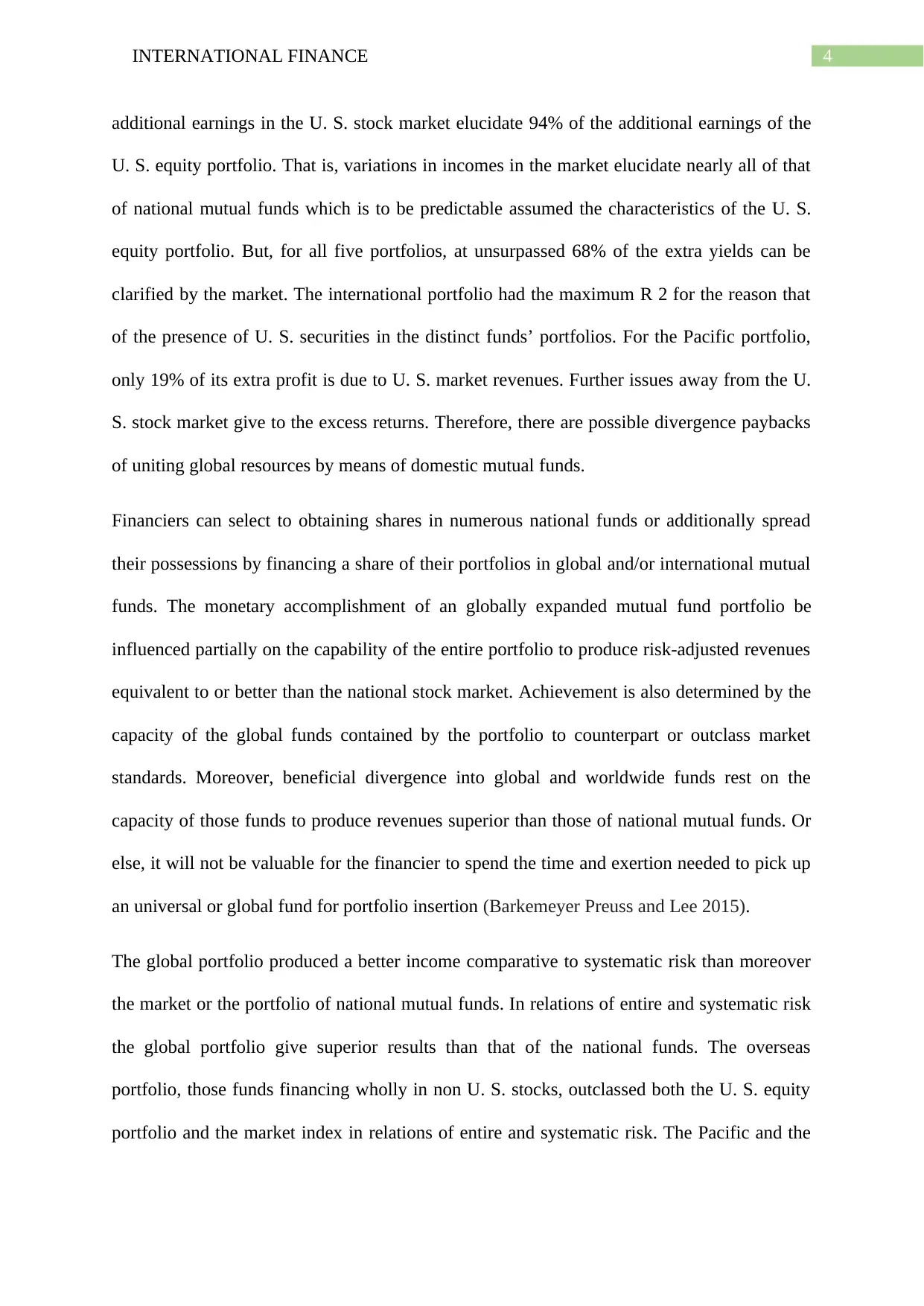
4INTERNATIONAL FINANCE
additional earnings in the U. S. stock market elucidate 94% of the additional earnings of the
U. S. equity portfolio. That is, variations in incomes in the market elucidate nearly all of that
of national mutual funds which is to be predictable assumed the characteristics of the U. S.
equity portfolio. But, for all five portfolios, at unsurpassed 68% of the extra yields can be
clarified by the market. The international portfolio had the maximum R 2 for the reason that
of the presence of U. S. securities in the distinct funds’ portfolios. For the Pacific portfolio,
only 19% of its extra profit is due to U. S. market revenues. Further issues away from the U.
S. stock market give to the excess returns. Therefore, there are possible divergence paybacks
of uniting global resources by means of domestic mutual funds.
Financiers can select to obtaining shares in numerous national funds or additionally spread
their possessions by financing a share of their portfolios in global and/or international mutual
funds. The monetary accomplishment of an globally expanded mutual fund portfolio be
influenced partially on the capability of the entire portfolio to produce risk-adjusted revenues
equivalent to or better than the national stock market. Achievement is also determined by the
capacity of the global funds contained by the portfolio to counterpart or outclass market
standards. Moreover, beneficial divergence into global and worldwide funds rest on the
capacity of those funds to produce revenues superior than those of national mutual funds. Or
else, it will not be valuable for the financier to spend the time and exertion needed to pick up
an universal or global fund for portfolio insertion (Barkemeyer Preuss and Lee 2015).
The global portfolio produced a better income comparative to systematic risk than moreover
the market or the portfolio of national mutual funds. In relations of entire and systematic risk
the global portfolio give superior results than that of the national funds. The overseas
portfolio, those funds financing wholly in non U. S. stocks, outclassed both the U. S. equity
portfolio and the market index in relations of entire and systematic risk. The Pacific and the
additional earnings in the U. S. stock market elucidate 94% of the additional earnings of the
U. S. equity portfolio. That is, variations in incomes in the market elucidate nearly all of that
of national mutual funds which is to be predictable assumed the characteristics of the U. S.
equity portfolio. But, for all five portfolios, at unsurpassed 68% of the extra yields can be
clarified by the market. The international portfolio had the maximum R 2 for the reason that
of the presence of U. S. securities in the distinct funds’ portfolios. For the Pacific portfolio,
only 19% of its extra profit is due to U. S. market revenues. Further issues away from the U.
S. stock market give to the excess returns. Therefore, there are possible divergence paybacks
of uniting global resources by means of domestic mutual funds.
Financiers can select to obtaining shares in numerous national funds or additionally spread
their possessions by financing a share of their portfolios in global and/or international mutual
funds. The monetary accomplishment of an globally expanded mutual fund portfolio be
influenced partially on the capability of the entire portfolio to produce risk-adjusted revenues
equivalent to or better than the national stock market. Achievement is also determined by the
capacity of the global funds contained by the portfolio to counterpart or outclass market
standards. Moreover, beneficial divergence into global and worldwide funds rest on the
capacity of those funds to produce revenues superior than those of national mutual funds. Or
else, it will not be valuable for the financier to spend the time and exertion needed to pick up
an universal or global fund for portfolio insertion (Barkemeyer Preuss and Lee 2015).
The global portfolio produced a better income comparative to systematic risk than moreover
the market or the portfolio of national mutual funds. In relations of entire and systematic risk
the global portfolio give superior results than that of the national funds. The overseas
portfolio, those funds financing wholly in non U. S. stocks, outclassed both the U. S. equity
portfolio and the market index in relations of entire and systematic risk. The Pacific and the
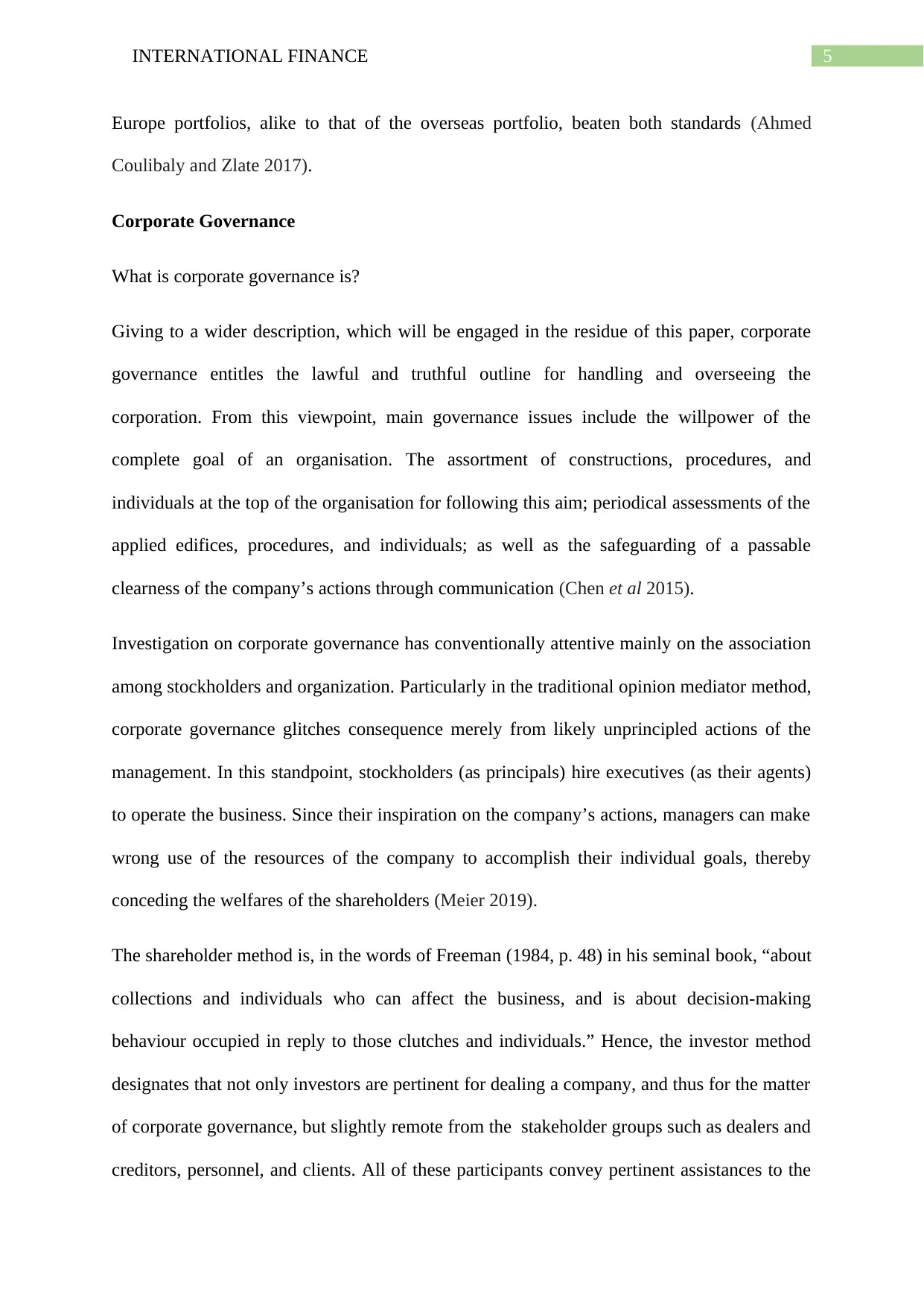
5INTERNATIONAL FINANCE
Europe portfolios, alike to that of the overseas portfolio, beaten both standards (Ahmed
Coulibaly and Zlate 2017).
Corporate Governance
What is corporate governance is?
Giving to a wider description, which will be engaged in the residue of this paper, corporate
governance entitles the lawful and truthful outline for handling and overseeing the
corporation. From this viewpoint, main governance issues include the willpower of the
complete goal of an organisation. The assortment of constructions, procedures, and
individuals at the top of the organisation for following this aim; periodical assessments of the
applied edifices, procedures, and individuals; as well as the safeguarding of a passable
clearness of the company’s actions through communication (Chen et al 2015).
Investigation on corporate governance has conventionally attentive mainly on the association
among stockholders and organization. Particularly in the traditional opinion mediator method,
corporate governance glitches consequence merely from likely unprincipled actions of the
management. In this standpoint, stockholders (as principals) hire executives (as their agents)
to operate the business. Since their inspiration on the company’s actions, managers can make
wrong use of the resources of the company to accomplish their individual goals, thereby
conceding the welfares of the shareholders (Meier 2019).
The shareholder method is, in the words of Freeman (1984, p. 48) in his seminal book, “about
collections and individuals who can affect the business, and is about decision-making
behaviour occupied in reply to those clutches and individuals.” Hence, the investor method
designates that not only investors are pertinent for dealing a company, and thus for the matter
of corporate governance, but slightly remote from the stakeholder groups such as dealers and
creditors, personnel, and clients. All of these participants convey pertinent assistances to the
Europe portfolios, alike to that of the overseas portfolio, beaten both standards (Ahmed
Coulibaly and Zlate 2017).
Corporate Governance
What is corporate governance is?
Giving to a wider description, which will be engaged in the residue of this paper, corporate
governance entitles the lawful and truthful outline for handling and overseeing the
corporation. From this viewpoint, main governance issues include the willpower of the
complete goal of an organisation. The assortment of constructions, procedures, and
individuals at the top of the organisation for following this aim; periodical assessments of the
applied edifices, procedures, and individuals; as well as the safeguarding of a passable
clearness of the company’s actions through communication (Chen et al 2015).
Investigation on corporate governance has conventionally attentive mainly on the association
among stockholders and organization. Particularly in the traditional opinion mediator method,
corporate governance glitches consequence merely from likely unprincipled actions of the
management. In this standpoint, stockholders (as principals) hire executives (as their agents)
to operate the business. Since their inspiration on the company’s actions, managers can make
wrong use of the resources of the company to accomplish their individual goals, thereby
conceding the welfares of the shareholders (Meier 2019).
The shareholder method is, in the words of Freeman (1984, p. 48) in his seminal book, “about
collections and individuals who can affect the business, and is about decision-making
behaviour occupied in reply to those clutches and individuals.” Hence, the investor method
designates that not only investors are pertinent for dealing a company, and thus for the matter
of corporate governance, but slightly remote from the stakeholder groups such as dealers and
creditors, personnel, and clients. All of these participants convey pertinent assistances to the
⊘ This is a preview!⊘
Do you want full access?
Subscribe today to unlock all pages.

Trusted by 1+ million students worldwide
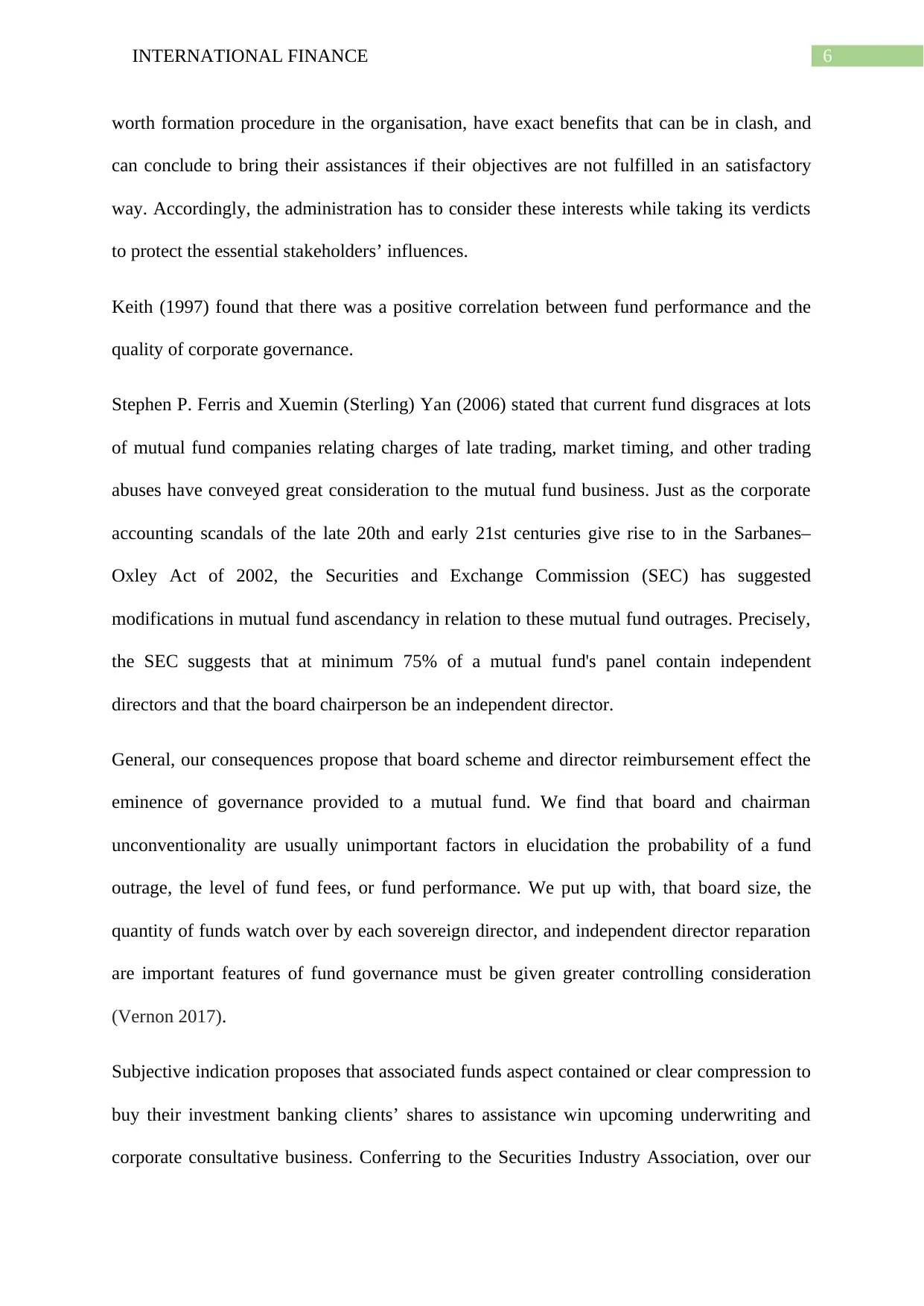
6INTERNATIONAL FINANCE
worth formation procedure in the organisation, have exact benefits that can be in clash, and
can conclude to bring their assistances if their objectives are not fulfilled in an satisfactory
way. Accordingly, the administration has to consider these interests while taking its verdicts
to protect the essential stakeholders’ influences.
Keith (1997) found that there was a positive correlation between fund performance and the
quality of corporate governance.
Stephen P. Ferris and Xuemin (Sterling) Yan (2006) stated that current fund disgraces at lots
of mutual fund companies relating charges of late trading, market timing, and other trading
abuses have conveyed great consideration to the mutual fund business. Just as the corporate
accounting scandals of the late 20th and early 21st centuries give rise to in the Sarbanes–
Oxley Act of 2002, the Securities and Exchange Commission (SEC) has suggested
modifications in mutual fund ascendancy in relation to these mutual fund outrages. Precisely,
the SEC suggests that at minimum 75% of a mutual fund's panel contain independent
directors and that the board chairperson be an independent director.
General, our consequences propose that board scheme and director reimbursement effect the
eminence of governance provided to a mutual fund. We find that board and chairman
unconventionality are usually unimportant factors in elucidation the probability of a fund
outrage, the level of fund fees, or fund performance. We put up with, that board size, the
quantity of funds watch over by each sovereign director, and independent director reparation
are important features of fund governance must be given greater controlling consideration
(Vernon 2017).
Subjective indication proposes that associated funds aspect contained or clear compression to
buy their investment banking clients’ shares to assistance win upcoming underwriting and
corporate consultative business. Conferring to the Securities Industry Association, over our
worth formation procedure in the organisation, have exact benefits that can be in clash, and
can conclude to bring their assistances if their objectives are not fulfilled in an satisfactory
way. Accordingly, the administration has to consider these interests while taking its verdicts
to protect the essential stakeholders’ influences.
Keith (1997) found that there was a positive correlation between fund performance and the
quality of corporate governance.
Stephen P. Ferris and Xuemin (Sterling) Yan (2006) stated that current fund disgraces at lots
of mutual fund companies relating charges of late trading, market timing, and other trading
abuses have conveyed great consideration to the mutual fund business. Just as the corporate
accounting scandals of the late 20th and early 21st centuries give rise to in the Sarbanes–
Oxley Act of 2002, the Securities and Exchange Commission (SEC) has suggested
modifications in mutual fund ascendancy in relation to these mutual fund outrages. Precisely,
the SEC suggests that at minimum 75% of a mutual fund's panel contain independent
directors and that the board chairperson be an independent director.
General, our consequences propose that board scheme and director reimbursement effect the
eminence of governance provided to a mutual fund. We find that board and chairman
unconventionality are usually unimportant factors in elucidation the probability of a fund
outrage, the level of fund fees, or fund performance. We put up with, that board size, the
quantity of funds watch over by each sovereign director, and independent director reparation
are important features of fund governance must be given greater controlling consideration
(Vernon 2017).
Subjective indication proposes that associated funds aspect contained or clear compression to
buy their investment banking clients’ shares to assistance win upcoming underwriting and
corporate consultative business. Conferring to the Securities Industry Association, over our
Paraphrase This Document
Need a fresh take? Get an instant paraphrase of this document with our AI Paraphraser
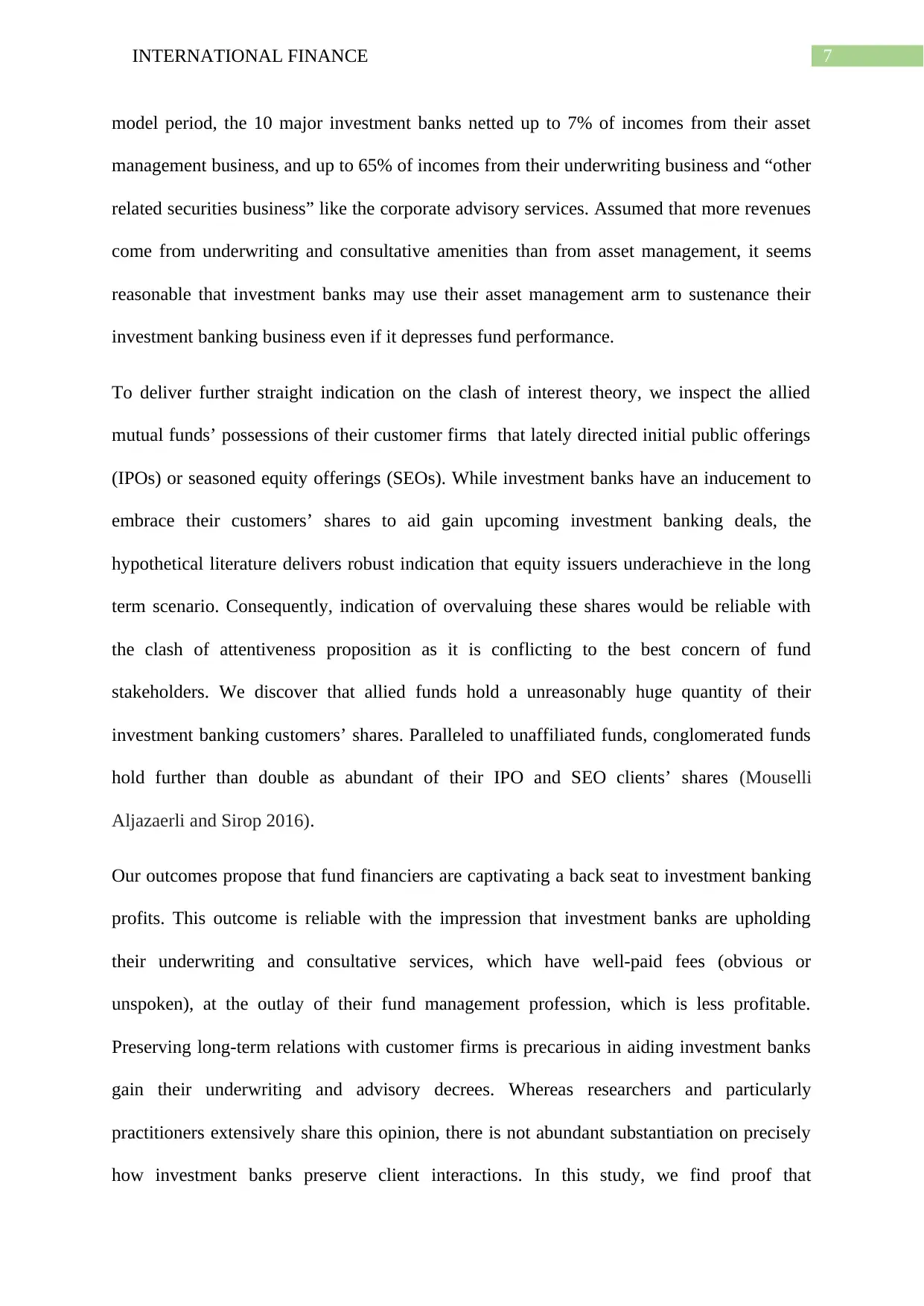
7INTERNATIONAL FINANCE
model period, the 10 major investment banks netted up to 7% of incomes from their asset
management business, and up to 65% of incomes from their underwriting business and “other
related securities business” like the corporate advisory services. Assumed that more revenues
come from underwriting and consultative amenities than from asset management, it seems
reasonable that investment banks may use their asset management arm to sustenance their
investment banking business even if it depresses fund performance.
To deliver further straight indication on the clash of interest theory, we inspect the allied
mutual funds’ possessions of their customer firms that lately directed initial public offerings
(IPOs) or seasoned equity offerings (SEOs). While investment banks have an inducement to
embrace their customers’ shares to aid gain upcoming investment banking deals, the
hypothetical literature delivers robust indication that equity issuers underachieve in the long
term scenario. Consequently, indication of overvaluing these shares would be reliable with
the clash of attentiveness proposition as it is conflicting to the best concern of fund
stakeholders. We discover that allied funds hold a unreasonably huge quantity of their
investment banking customers’ shares. Paralleled to unaffiliated funds, conglomerated funds
hold further than double as abundant of their IPO and SEO clients’ shares (Mouselli
Aljazaerli and Sirop 2016).
Our outcomes propose that fund financiers are captivating a back seat to investment banking
profits. This outcome is reliable with the impression that investment banks are upholding
their underwriting and consultative services, which have well-paid fees (obvious or
unspoken), at the outlay of their fund management profession, which is less profitable.
Preserving long-term relations with customer firms is precarious in aiding investment banks
gain their underwriting and advisory decrees. Whereas researchers and particularly
practitioners extensively share this opinion, there is not abundant substantiation on precisely
how investment banks preserve client interactions. In this study, we find proof that
model period, the 10 major investment banks netted up to 7% of incomes from their asset
management business, and up to 65% of incomes from their underwriting business and “other
related securities business” like the corporate advisory services. Assumed that more revenues
come from underwriting and consultative amenities than from asset management, it seems
reasonable that investment banks may use their asset management arm to sustenance their
investment banking business even if it depresses fund performance.
To deliver further straight indication on the clash of interest theory, we inspect the allied
mutual funds’ possessions of their customer firms that lately directed initial public offerings
(IPOs) or seasoned equity offerings (SEOs). While investment banks have an inducement to
embrace their customers’ shares to aid gain upcoming investment banking deals, the
hypothetical literature delivers robust indication that equity issuers underachieve in the long
term scenario. Consequently, indication of overvaluing these shares would be reliable with
the clash of attentiveness proposition as it is conflicting to the best concern of fund
stakeholders. We discover that allied funds hold a unreasonably huge quantity of their
investment banking customers’ shares. Paralleled to unaffiliated funds, conglomerated funds
hold further than double as abundant of their IPO and SEO clients’ shares (Mouselli
Aljazaerli and Sirop 2016).
Our outcomes propose that fund financiers are captivating a back seat to investment banking
profits. This outcome is reliable with the impression that investment banks are upholding
their underwriting and consultative services, which have well-paid fees (obvious or
unspoken), at the outlay of their fund management profession, which is less profitable.
Preserving long-term relations with customer firms is precarious in aiding investment banks
gain their underwriting and advisory decrees. Whereas researchers and particularly
practitioners extensively share this opinion, there is not abundant substantiation on precisely
how investment banks preserve client interactions. In this study, we find proof that
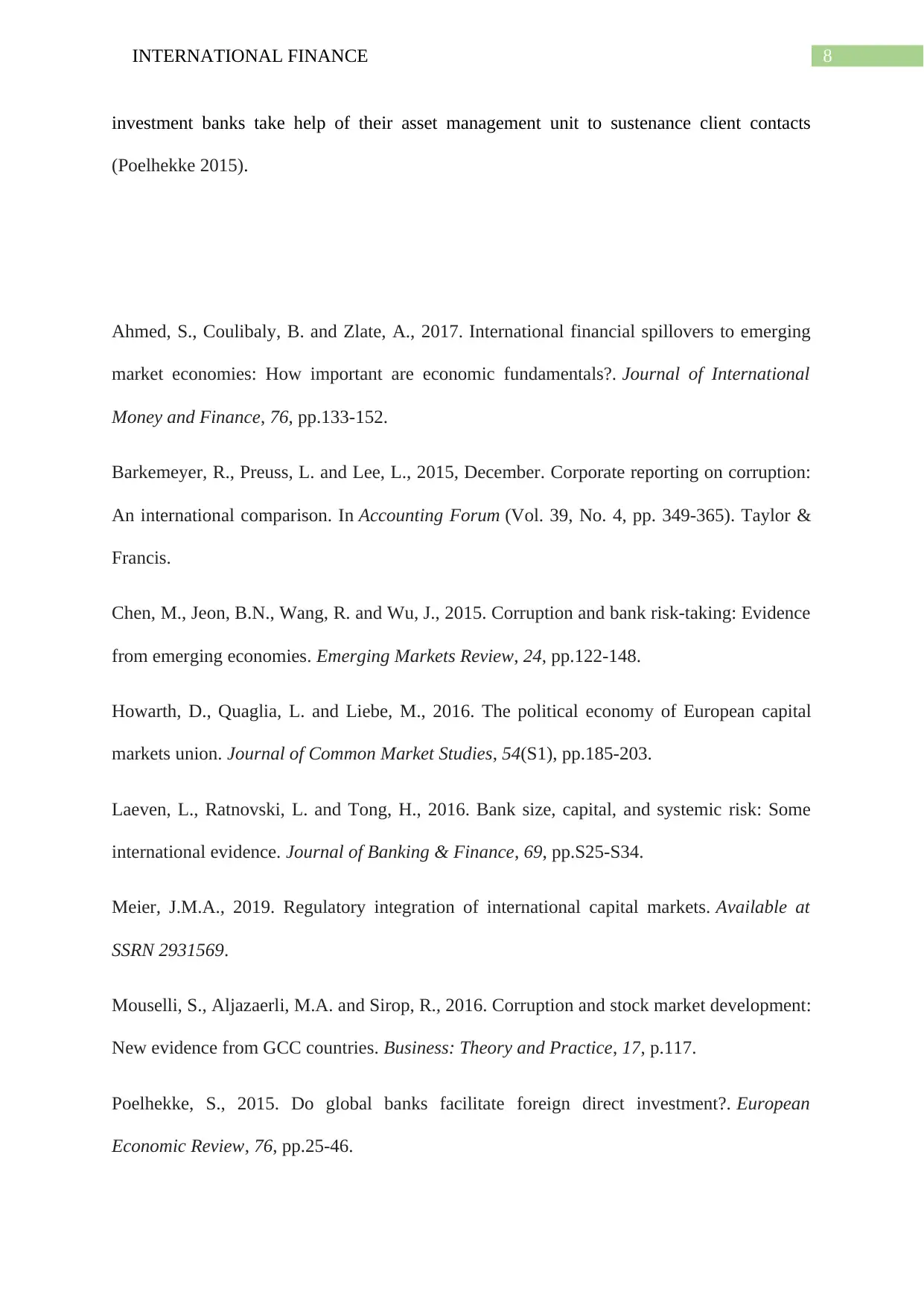
8INTERNATIONAL FINANCE
investment banks take help of their asset management unit to sustenance client contacts
(Poelhekke 2015).
Ahmed, S., Coulibaly, B. and Zlate, A., 2017. International financial spillovers to emerging
market economies: How important are economic fundamentals?. Journal of International
Money and Finance, 76, pp.133-152.
Barkemeyer, R., Preuss, L. and Lee, L., 2015, December. Corporate reporting on corruption:
An international comparison. In Accounting Forum (Vol. 39, No. 4, pp. 349-365). Taylor &
Francis.
Chen, M., Jeon, B.N., Wang, R. and Wu, J., 2015. Corruption and bank risk-taking: Evidence
from emerging economies. Emerging Markets Review, 24, pp.122-148.
Howarth, D., Quaglia, L. and Liebe, M., 2016. The political economy of European capital
markets union. Journal of Common Market Studies, 54(S1), pp.185-203.
Laeven, L., Ratnovski, L. and Tong, H., 2016. Bank size, capital, and systemic risk: Some
international evidence. Journal of Banking & Finance, 69, pp.S25-S34.
Meier, J.M.A., 2019. Regulatory integration of international capital markets. Available at
SSRN 2931569.
Mouselli, S., Aljazaerli, M.A. and Sirop, R., 2016. Corruption and stock market development:
New evidence from GCC countries. Business: Theory and Practice, 17, p.117.
Poelhekke, S., 2015. Do global banks facilitate foreign direct investment?. European
Economic Review, 76, pp.25-46.
investment banks take help of their asset management unit to sustenance client contacts
(Poelhekke 2015).
Ahmed, S., Coulibaly, B. and Zlate, A., 2017. International financial spillovers to emerging
market economies: How important are economic fundamentals?. Journal of International
Money and Finance, 76, pp.133-152.
Barkemeyer, R., Preuss, L. and Lee, L., 2015, December. Corporate reporting on corruption:
An international comparison. In Accounting Forum (Vol. 39, No. 4, pp. 349-365). Taylor &
Francis.
Chen, M., Jeon, B.N., Wang, R. and Wu, J., 2015. Corruption and bank risk-taking: Evidence
from emerging economies. Emerging Markets Review, 24, pp.122-148.
Howarth, D., Quaglia, L. and Liebe, M., 2016. The political economy of European capital
markets union. Journal of Common Market Studies, 54(S1), pp.185-203.
Laeven, L., Ratnovski, L. and Tong, H., 2016. Bank size, capital, and systemic risk: Some
international evidence. Journal of Banking & Finance, 69, pp.S25-S34.
Meier, J.M.A., 2019. Regulatory integration of international capital markets. Available at
SSRN 2931569.
Mouselli, S., Aljazaerli, M.A. and Sirop, R., 2016. Corruption and stock market development:
New evidence from GCC countries. Business: Theory and Practice, 17, p.117.
Poelhekke, S., 2015. Do global banks facilitate foreign direct investment?. European
Economic Review, 76, pp.25-46.
⊘ This is a preview!⊘
Do you want full access?
Subscribe today to unlock all pages.

Trusted by 1+ million students worldwide
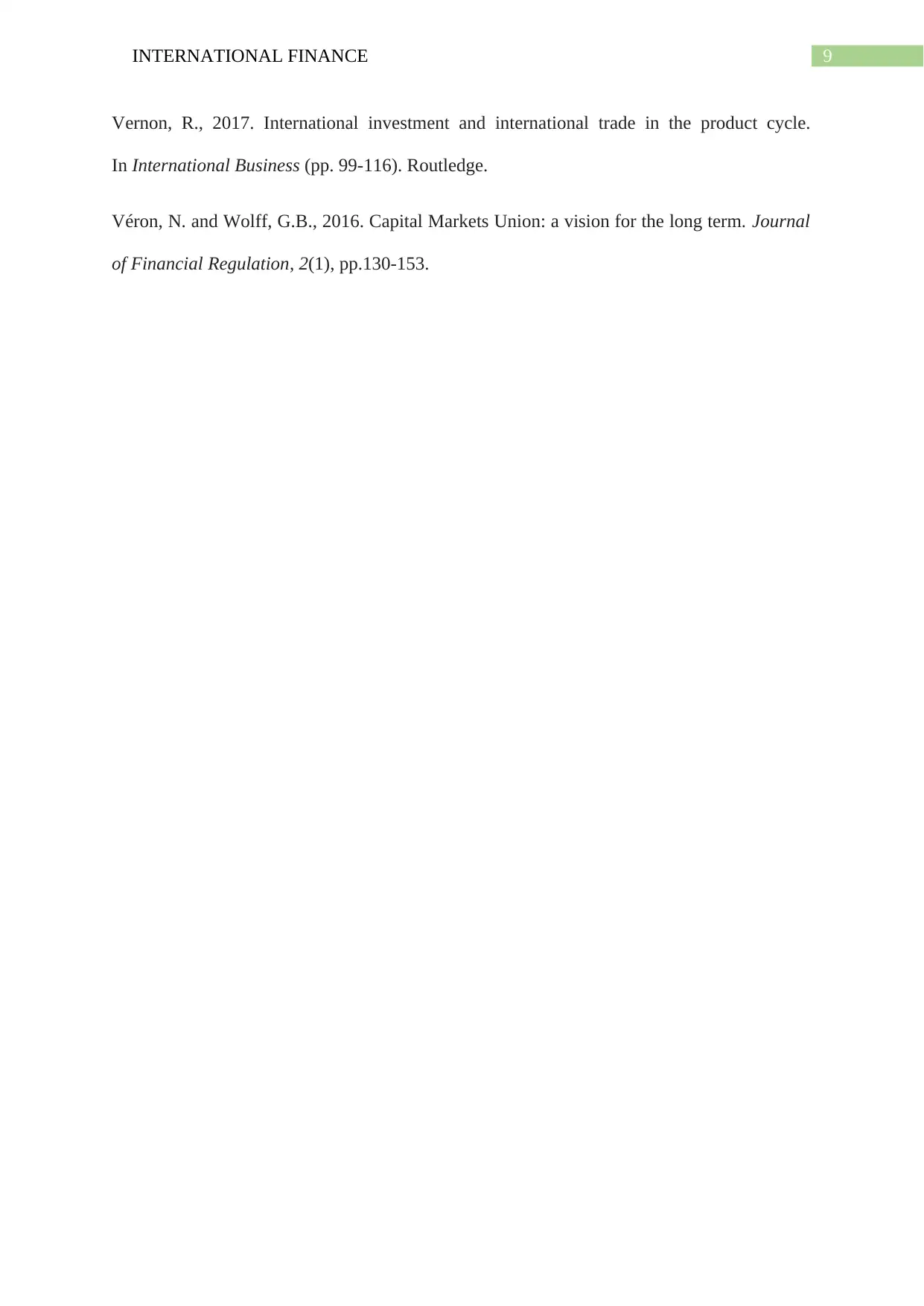
9INTERNATIONAL FINANCE
Vernon, R., 2017. International investment and international trade in the product cycle.
In International Business (pp. 99-116). Routledge.
Véron, N. and Wolff, G.B., 2016. Capital Markets Union: a vision for the long term. Journal
of Financial Regulation, 2(1), pp.130-153.
Vernon, R., 2017. International investment and international trade in the product cycle.
In International Business (pp. 99-116). Routledge.
Véron, N. and Wolff, G.B., 2016. Capital Markets Union: a vision for the long term. Journal
of Financial Regulation, 2(1), pp.130-153.
1 out of 10
Related Documents
Your All-in-One AI-Powered Toolkit for Academic Success.
+13062052269
info@desklib.com
Available 24*7 on WhatsApp / Email
![[object Object]](/_next/static/media/star-bottom.7253800d.svg)
Unlock your academic potential
Copyright © 2020–2025 A2Z Services. All Rights Reserved. Developed and managed by ZUCOL.



